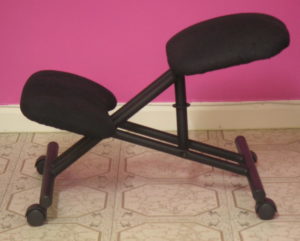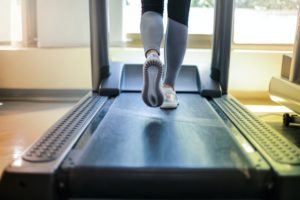We all know now that “sitting is the new smoking.” Too much time sitting has been implicated as a factor in various diseases, including heart disease, cancer, depression, and joint problems. Even if you don’t sit enough to cause severe and long term health problems, you may experience short term consequences like back and neck pain. Sitting at work for eight hours is a common cause of musculoskeletal problems. All that sitting causes your hamstrings to tighten and can weaken the large muscles in your thighs, buttocks, and core. These muscles are responsible for your ability to balance, and weak muscles in these areas can make you more prone to falls and injury. Don’t worry, sitting less is simpler than you might think. Here are four healthier alternatives to your desk chair:
1. A Fitness Ball
Fitness balls are easy to incorporate into an office space in place of a traditional desk chair. It may not look much different from how you usually sit, but fitness balls are a bit difficult to sit on. You have to engage your core muscles to keep yourself in place. You get a mini-workout while you do your work as usual.
How to try it: If you are out of shape or feel that you have a weak core, you may want to start slow and work your way up to a whole workday. You could begin by sitting on your fitness ball for two hours in the morning. After this becomes easier, try to make it until lunch and keep adding on time from there.
Benefits: Because you will be strengthening your core, your lower back will hurt less. It’s also difficult to hunch forward on a fitness ball, so your upper back and neck might also feel better. You may notice improved core strength and better balance after several weeks.

2. A Kneeling Chair
These chairs look odd, but if you suffer from hip pain or stiffness, they can be a dream come true. Like a fitness ball, they are easy to switch out for your office chair.
How to Try it: These chairs can take a bit of getting used to. You might want to do a short trial run. Since you will need to maintain an upright posture while using this chair, you may want to start slow and work your way up, especially if your core is weak. Those with knee pain should not use a kneeling chair.
Benefits: Kneeling chairs relieve pressure on your hips and keep your spine correctly aligned. After regular use, you will notice that your hip and back pain will be reduced. As a result of less pain and stiffness, you may also feel more energetic. If you maintain an upright posture without slouching forward, then your neck will also thank you.

3. A Standing Desk
This option solves your sitting problem by getting you off your bum, but it can also be harder to incorporate into your office space. If you can’t have a standing desk, try a standing desk converter. These start around $80 and allow you to move your monitor and keyboard up to a standing height. They are easily adjustable, so you can move them back down again if you feel the need to sit for a while.
How to Try it: Set up your standing desk or a converter so that your monitor is at eye level and your keyboard is in a comfortable position. If you tend to stand in one position and find yourself feeling stiff, try putting a block that’s about 4-6 inches high on the floor and switch off-putting one foot on it. Make sure you are wearing good quality shoes that properly support your foot type. If you find it tiring to stand for eight hours, try standing for half a day instead.
Benefits: Our digestive systems and cardiovascular systems both function better when we are in an upright position. You might notice that you don’t gain as much weight after you start standing for most of your day. Your back, neck, and core will also be stronger and under less strain. As long as you are wearing good shoes and looking straight ahead at your monitor, you should notice a reduction in pain and stiffness.

4. A Treadmill Desk
If you are serious about fitness, this might be the desk for you. It not only gets you off your bum; it also gets you moving. Treadmill desks allow you to walk (slowly) while you do your work as usual. They are best for people who feel they have the fitness level to walk for a long time.
How to Try it: Getting a treadmill desk into your office might require permission from your boss, but if you’ve got the A-OK and you’ve moved it in, then all you have to do is turn it on. You may want to use it for only part of your day at first and then work your way up. If you like the idea of walking at work but aren’t ready for a treadmill desk, try walking in place at your standing desk. If you can keep yourself going for a while, the benefits will be the same. Make sure you are wearing supportive footwear while you use your treadmill desk, and position your monitor at eye level.
Benefits: A treadmill desk allows you to efficiently use your time, so you don’t have to go to the gym every day after work. All that movement may help you lose weight which will reduce your risk for heart problems and type 2 diabetes. Studies have found that the human body functions optimally when we walk five miles per day, even at a slow pace, this goal shouldn’t be hard to hit during your workday.






